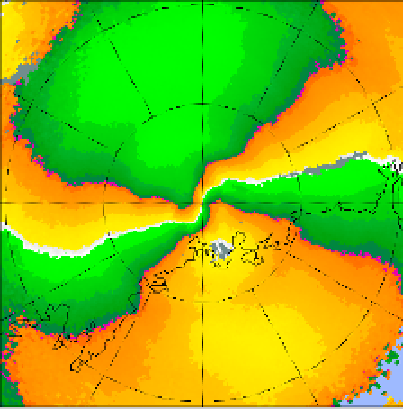Geoscience Reference
In-Depth Information
4. Clutter cancellation and clear air echoes
One of the main reasons why operational weather services started to use Doppler radars
was the use of Doppler signal for clutter cancellation of reflectivity fields. The principle is
simple: precipitation has velocity (at least fallspeed and turbulence), while ground clutter
does not, and Doppler radar can measure the velocity (or absence thereof). However, when
the precipitation is in form of snow, there are some complicating details, and we have to
study the filtering process in depth.
A Doppler radar does not measure the true speed of the particles, just the component
parallel to the radar beam. When the real wind is nearly perpendicular to the beam (e.g.
for northerly winds in east and west of radar), this component is near zero. We can not set
the threshold to censor only the bins with exactly zero speed, because even clutter targets
have apparent speeds due to different viewing angle of the rotating antenna, trees and
masts waving in wind and trucks and lorries in an urban environment. On the other
hand, if the threshold of censorship is too high, Doppler filter removes data with near-
zero Doppler velocities in areas where wind is perpendicular to beam. Because there is
wind shear and measurement is made at different heights at different distances, the
direction of missing data is undulating, and hence the gap in reflectivity PPIs is
sometimes called
Doppler snake.
In Fig. 3, it is relatively easy to see the underestimation of reflectivity on a line coiling
from west-southwest through the radar and to the opposite side. In this case, there is also
a “secondary snake” south of the radar, where the near-zero-velocities are related to
folding.
Fig. 3. A Doppler snake case 17 March 2005 03:00 UTC. PPIs of reflectivity (left) and Doppler
velocity (right). Wind is from south-southeast, warm colours indicate echoes moving away
from the radar and cold colours towards the radar . The velocity field is folded,
unambiguous speed 7.6 m/s. A band of weaker reflectivities cutting through the image from
southwest to east, at same location as zero Doppler speeds (white). Reflectivity colour scale
as in Fig. 2.



